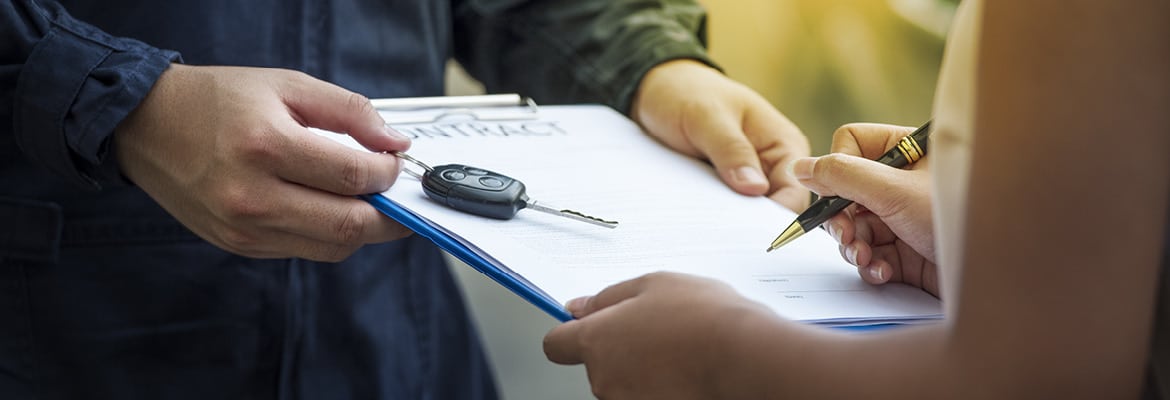Author(s)
If you need a new car, but don’t want to spend the money on a brand new vehicle, a used car is generally a great option. Buyers should always be careful when buying used cars—checking CARFAX for the vehicle’s history, total mileage, whether it was in any accidents, etc.
One thing buyers don’t always think about when looking for a used car is whether the vehicle has incurred any water damage. Even though used vehicle inventory is normalizing, you may need to be extra careful when shopping as more flood-damaged vehicles will be entering the marketplace and sellers may not be forthcoming with this information.
Recent hurricanes
In July 2024, Category 5 Hurricane Beryl impacted the Gulf Coast of the United States, the Yucatan Peninsula, and parts of the Caribbean. It broke meteorological records for its formation and intensity, resulting in at least $3.3 billion in damages. Many of these damages include vehicles, with flooded and water damaged cars still being recovered today.
Additionally, Category 1 Hurricane Debby brought widespread flooding across the southeastern United States. Hurricane Debby formed on August 3, 2024 and was lowered to a post-tropical cyclone on August 9, 2024. To date, the storm has caused over 13 million dollars in damages. As with most storms of this magnitude, the cost of damages is expected to rise as flooded vehicles surface in the coming weeks and months.
With flooding affecting large areas across the country, thousands of vehicles are at risk of water damage. Many flooded vehicles will be inoperable, with others sustaining less severe damages. However, even vehicles with seemingly minor water damage can experience major malfunctions in the future. Water-damaged vehicles will appear on used car lots after major storms, and it’s important that car-buyers know how to spot them.
Purchasing a water-damaged car is something you want to avoid as it can continually take money out of your pocket. What’s worse is that sometimes you won’t be able to tell if a car has water damage just by looking at it. The following tips will help you avoid buying a water-damaged used car.
Identifying water damage in cars
- Check the title
When hurricanes and strong storms hit, thousands of cars feel the blow. If the cars are insured, the insurance companies handle the water-damaged vehicles by hiring businesses that auction the vehicles off to dealers around the country. When a company or dealer is trying to resell a vehicle, the title must indicate whether it is a salvaged vehicle, indicating it was involved in a major accident or natural disaster.
Additionally, it’s critical to be aware that people may experience water damage but never report the damage to insurance, instead “fixing” it themselves and selling the car privately. If you are involved in a private sale, you are putting yourself at risk for purchasing a car with unreported water damage.
- Look for gaps in vehicle history reports
Checking the car title for “salvage” should be a fool-proof way to avoid buying a used car with water damage, but sometimes it’s not enough. To go the extra mile, look at vehicle history reports such as CARFAX or AutoCheck. If the car was in an accident it should be on the report, but water damage may not always be indicated. However, if the report has any gaps you will want to check them out and dig a little deeper. Ask questions and try to get answers on what happened during the gap. Also, if you see the car was recently purchased from an auto auction in Texas, Florida, Georgia, North Carolina, South Carolina, or other places where recent flooding may have occurred, you may want to reconsider your interest in the car.
When looking at reports, you also want to be wary of a vehicle that has multiple registrations in different states. Some states do not require certain information to be recorded, so sellers may just be finding loopholes to hide the ugly parts of the vehicle’s history.
- Look for signs of water damage
Though this tip may seem obvious, signs of water damage are often hard to see. Individuals and companies can make cosmetic changes to a vehicle to hide the fact that it was damaged. The following will help you spot clues that there may be existing water damage:
- Check below the seats, trunk, glove compartment, and dashboard for rust, mud, or dirt
- Make sure the color of the interior upholstery is the same throughout. If not, it can indicate replacements. If parts are stained or dirty, it can indicate water damage
- Make sure all electrical parts of the car work properly. Test the radio, windshield wipers, heating, air conditioning, and turn signals
- Examine headlights and tail lights for water or condensation
- Check for smells of dampness or mildew
- Have a mechanic check the vehicle for an inspection before purchasing
- Take extra precautions
Even after taking the three steps above, there are still plenty of water-damaged vehicles that slip through the cracks. If you have a flooded or water-damaged vehicle, there is a huge unknown in terms of how well it will operate over time. When purchasing a used vehicle, you can protect yourself as a consumer with an extended warranty, then take it to a mechanic for a pre-purchase inspection or appraisal. If you live in states that have a higher risk for flooding—Florida, Louisiana, Texas, Alabama, South Carolina, etc.—it’s especially important to take these measures when purchasing a used car.
If your car has suffered water damage or was flooded in recent storms, there are steps you can take to prevent further damage. Learn what to do if your car is flooded.
Buying a car is exciting and a large investment. Before you put any money down on a used vehicle, make sure you do your homework and check everything you can to ensure your car doesn’t have water damage.








